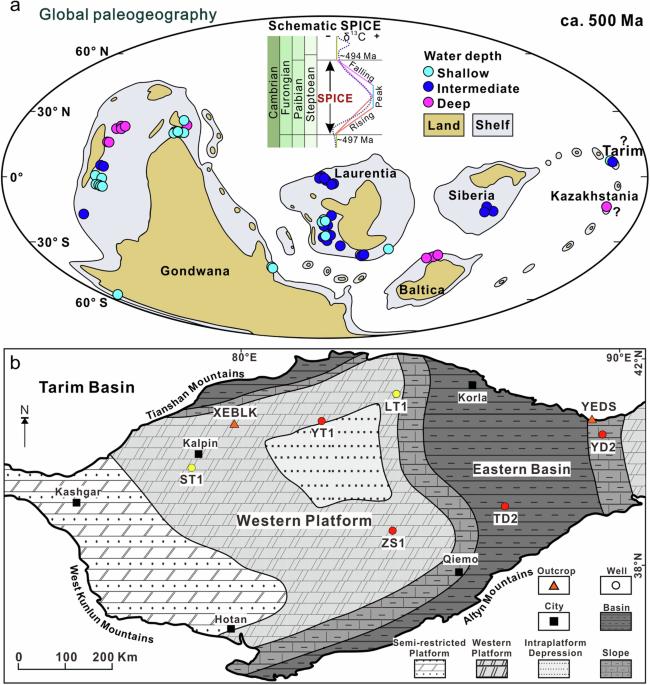Sedimentary facies controlled biogeochemical process of biotic extinction and turnover across the Cambrian SPICE event
IF 8.1
1区 地球科学
Q1 ENVIRONMENTAL SCIENCES
引用次数: 0
Abstract
The Steptoean positive carbon isotope excursion (SPICE) event, one of the largest carbon cycle perturbations in the Cambrian, coincides with shallow-shelf-fauna extinction and plankton revolution (critical transition of plankton). The event is globally documented, but biogeochemical responses of these biotic evolutions in varying facies environments are not well understood. Here high-resolution paired δ18Ocarb, δ13Ccarb and δ13Corg datasets from varied paleodepth environments in the Tarim Basin, NW China reveal facies-dependent signatures of the event, with globally synchronous patterns but notable intra-basinal variability. Shallow marine facies record the end-Marjuman extinction with a distinct negative δ13Corg excursion prior to the event, while the transitional facies region marks twice positive δ13C excursions corresponding to an asynchronous plankton revolution from shallow and deep areas during the event. The varying isotope responses are interpreted in the context of primary productivity and redox conditions, with deeper basins recording more 13C enriched signals (i.e., higher δ13C) due to greater organic matter preservation under anoxic conditions, compared to the platform area. The biotic extinction, the planktonic revolution and the interaction of organisms along the shallow to deep marine depth gradient were reflected by the significant isotopic shifts recorded during the event, suggesting depth-dependent biogeochemical processes that shaped marine ecosystems. Biogeochemical responses to one of the largest carbon cycle perturbations taking place 497 to 494 million years ago, show variability within sedimentary basins and reflect primary productivity and redox conditions, according to high-resolution carbon and oxygen isotope analyses from the Tarim Basin, China.

寒武纪 SPICE 事件中生物灭绝和更替的沉积面控制生物地球化学过程
寒武纪最大的碳循环扰动之一--斯泰普图恩正碳同位素偏移(SPICE)事件与浅海底栖生物灭绝和浮游生物革命(浮游生物的临界过渡)同时发生。该事件在全球范围内都有记录,但人们对这些生物进化在不同地层环境中的生物地球化学响应却不甚了解。在此,来自中国西北部塔里木盆地不同古深度环境的高分辨率成对δ18Ocarb、δ13Ccarb 和 δ13Corg数据集揭示了这一事件的地貌特征,即全球同步模式,但盆地内部存在显著差异。浅海海相记录了玛儒曼大灭绝前明显的负δ13Corg偏移,而过渡海相区域则记录了两次正δ13C偏移,这与大灭绝期间浅海和深海区域浮游生物的不同步变化相对应。与平台区相比,由于缺氧条件下有机物保存较多,深层盆地记录了更多的 13C 富集信号(即更高的 δ13C)。生物大灭绝、浮游生物革命以及从浅海到深海深度梯度上生物之间的相互作用都反映在该事件期间记录到的显著同位素变化中,这表明影响海洋生态系统的生物地球化学过程与深度有关。根据对中国塔里木盆地的高分辨率碳和氧同位素分析,生物地球化学对距今4.97亿年至4.94亿年前发生的最大碳循环扰动之一的反应显示了沉积盆地内的可变性,并反映了初级生产力和氧化还原条件。
本文章由计算机程序翻译,如有差异,请以英文原文为准。
求助全文
约1分钟内获得全文
求助全文
来源期刊

Communications Earth & Environment
Earth and Planetary Sciences-General Earth and Planetary Sciences
CiteScore
8.60
自引率
2.50%
发文量
269
审稿时长
26 weeks
期刊介绍:
Communications Earth & Environment is an open access journal from Nature Portfolio publishing high-quality research, reviews and commentary in all areas of the Earth, environmental and planetary sciences. Research papers published by the journal represent significant advances that bring new insight to a specialized area in Earth science, planetary science or environmental science.
Communications Earth & Environment has a 2-year impact factor of 7.9 (2022 Journal Citation Reports®). Articles published in the journal in 2022 were downloaded 1,412,858 times. Median time from submission to the first editorial decision is 8 days.
 求助内容:
求助内容: 应助结果提醒方式:
应助结果提醒方式:


